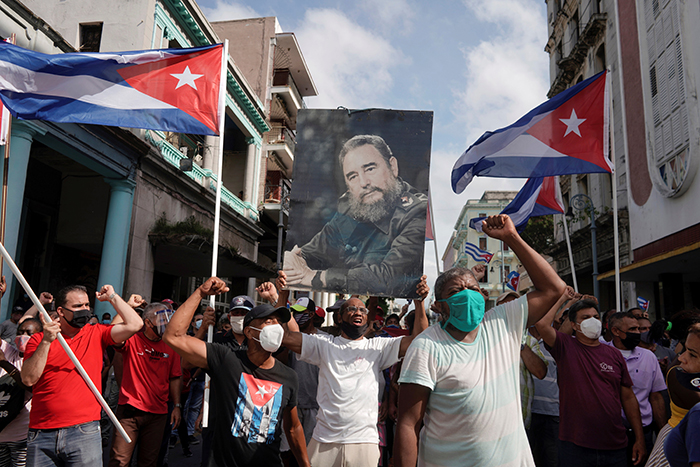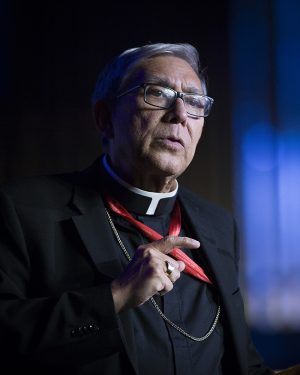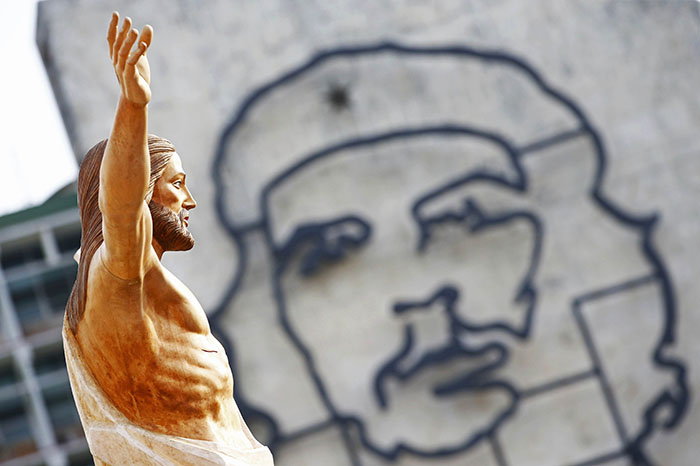
WINDSOR TERRACE — The image of a bearded, longhaired man in a beret, Che Guevara, has evolved into a worldwide icon glorifying popular rebellion, but not for retired Auxiliary Bishop Octavio Cisneros.
Bishop Cisneros recounted how Guevara carried out the strong-arm directives of the late dictator Fidel Castro, who, after the Revolution of 1959, chased nearly 75% of the Catholic clergy from Cuba. Bishop Cisneros was born there in 1945.
The revolution, he said, began an era of repression of the Catholic Church in Cuba.
On Sunday, July 11, Cuban citizens — many of them Catholic — took the rare risk of protesting against ongoing shortages of food, economic opportunity, and COVID-19 vaccines.
Bishop Cisneros said he could not predict if these protests signal a new era for Cuban Catholics. But they are a significant contrast to the early 1960s when Castro tightened his grip on Cuba and the church.
“He espoused every Democratic principle,” Bishop Cisneros said of the dictator’s early days in power. “The Revolution of 1959 was a revolution of democracy. All that’s historical because the signatures on all those documents exist. However, in 1961, he decides that the country is a Leninist, communist country, in the ways of Stalin.
“And that is the moment — the defining moment — of him breaking away from the democratic aspirations of the republic of the revolution, into now, a form of communism. This is the time when 14,000 children left Cuba, and I’m one of them.”

The mass evacuation, known as “Operation Peter Pan,” was organized and led by the Catholic Church. It involved airlifting thousands of children ages 6-18 out of Cuba from 1960-1962. Among them was high school student Octavio Cisneros — who has since spent much of his life as a Catholic clergyman, and, though now retired, is still serving the Diocese of Brooklyn.
In 1960s Cuba, some parents feared the Castro government would put their children into communist indoctrination centers. So instead, they evacuated their children to the U.S.
Meanwhile, the Jesuit-educated Castro ordered the Communist tactic of separating people from religion.
“At that time,” Bishop Cisneros said, “priests and bishops were thrown out of Cuba — 130 of them. Think of it. I don’t know the exact number, but I’m sure Cuba didn’t have 200 of them. After that, priests were very, very few.”
Guevara, Castro’s Argentinian-born henchman, presided over the repression and terrorizing of political opponents.
“Here was the hero of the revolution,” said Bishop Cisneros. “But for people who were prisoners, Guevara was the one in charge of killing.
“Sometimes they would take the prisoners and say, ‘We’re going to kill you.’ And they put them on the wall, but it was a farce. Can you imagine internal tension within a person thinking he was going to be shot?”
Therefore, the bishop said that he doesn’t see a revolutionary worthy of acclaim whenever he notices Guevara’s face on a t-shirt. When asked to describe what he does see in the image, he flatly said, “the devil.”
Bishop Cisneros also noted Castro was careful not to remove church buildings, but not for spiritual reasons.
“He never took over the churches,” the bishop said. “But he took the schools. He took the agencies. He took the convents. He took all the ancillary work of the church. People could still go and sit down in a church, but it was limited to worshiping.
“I cannot read the mind of Castro, but I would say that probably he thought that he could not just uproot the faith of the people. If he removed everything, then it might have been more difficult for him.
“On the other hand, the church was limited by the government to deal with piety and the sacraments. If there is no school, there is no catechism. So most of Cuba at that time was not catechized, and we’re dealing with that right now.”
By 1986, Cuban Catholics organized to win back their abilities to evangelize the unchurched and learn ways to preserve their faith amid government hostility.
This grassroots movement, the Cuban National Ecclesial Meeting (ENEC), is known for its historical roadmap for Catholic evangelism in Cuba.
Meanwhile, Castro ignored Cuban bishops, although he did allow the Vatican to keep an apostolic nuncio in Havana. But again, the dictator’s motive had nothing to do with feeding the spirituality of Cubans, Bishop Cisneros said.
“It’s propaganda,” he said. “Cuba has to tell the world it is an open society, that the people have freedom of worship to pray over everything. But everything that the government does is propaganda. Every single thing — nothing is done for nothing.”
Perhaps that is what Castro had in mind when he visited Pope John Paul II at the Vatican in 1996. He invited the pope to visit Cuba, which he did two years later, the first pontiff ever to do that.
“That was a very famous visit,” Bishop Cisneros said. “The pope comes, and the pope is received like he would be received in the United States, if not better.”
The bishop reminded that “Everything is done because the world has to see that this society is an open society.” But, he added, “things started to open up.”
“Christmas was restored,” he said, “because Castro had abolished Christmas.”
Bishop Cisneros recalled how a massive image of a Sacred Heart was briefly allowed to cover a mural of Che Guevara’s face on a government building. Subsequently, people unpacked Sacred Hearts and proudly displayed them at home.
Popes Benedict and Francis also visited Cuba, which brought more progress.
Clearly, Bishop Cisnero said, the Holy Spirit has been working in Cuba.
“He is always working,” the bishop said, smiling broadly. “Do you doubt that?”
Now, acting on roadmaps formed by the ENEC and other conventions, Catholic clergy and laity are playing catch-up, extending catechesis to fellow Cubans. The result, Bishop Cisneros said, is a Cuban Catholic of unique character — one who is not distracted by pop culture but instead focused on spiritual growth.
The July 11 protests unleashed a boldness among Cubans clamoring against shortages of food and vaccines and proclaiming, “No tenemos miedo (We are not afraid).”
Some rallied around statues of Mary, Our Lady of Charity. Still, others keep watch on the government in anticipation of violent crackdowns.
“The outcome — I just hope it can be done through peaceful dialog, perhaps with pressure from outside Cuba, and not the U.S. only,” Bishop Cisneros said. “I hope it is a first step.
“People don’t want to leave Cuba. No. They’re saying, ‘We’re Cubans, and we demand the basic rights.’ People are hungry.”

